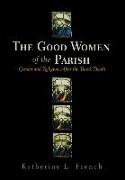- Start
- The Good Women of the Parish: Gender and Religion After the Black Death
The Good Women of the Parish: Gender and Religion After the Black Death
Angebote / Angebote:
The Good Women of the ParishGender and Religion After the Black DeathKatherine L. French"Contains a wealth of interesting detail, much of it culled from those churchwardens' account that had begun to be kept in the fourteenth century. Women themselves might act as churchwardens, but as French makes abundantly clear throughout her book, such a role was only one among many that women in the late English medieval parish might exercise. French may not with to argue that the Reformation was 'bad' for women, but she does make it clear that thereafter women had to learn--the phrase is hers--quite a new 'vocabulary of piety.'"--Journal of British StudiesThere was immense social and economic upheaval between the Black Death and the English Reformation, and contemporary writers often blamed this upheaval on immorality, singling out women's behavior for particular censure. Late medieval moral treatises and sermons increasingly connected good behavior for women with Christianity, and their failure to conform to sin. Katherine L. French argues, however, that medieval laywomen both coped with the chaotic changes following the plague and justified their own changing behavior by participating in local religion. Through active engagement in the parish church, the basic unit of public worship, women promoted and validated their own interests and responsibilities.Scholarship on medieval women's religious experiences has focused primarily on elite women, nuns, and mystics who either were literate enough to leave written records of their religious ideas and behavior or had access to literate men who did this for them. Most women, however, were not literate, were not members of religious orders, and did not have private confessors. As The Good Women of the Parish shows, the great majority of women practiced their religion in a parish church. By looking at women's contributions to parish maintenance, the ways they shaped the liturgy and church seating arrangements, and their increasing opportunities for collective action in all-women's groups, the book argues that gendered behavior was central to parish life and that women's parish activities gave them increasing visibility and even, on occasion, authority. In the face of demands for silence, modesty, and passivity, women of every social status used religious practices as an important source of self-expression, creativity, and agency.Katherine L. French is Associate Professor of History, State University of New York, New Paltz. She is the author of , also published by the University of Pennsylvania Press.The Middle Ages Series2007 | 352 pages | 6 x 9 | 19 illus.ISBN 978-0-8122-4053-5 | Cloth | $69.95s | �.50 ISBN 978-0-8122-0196-3 | Ebook | $69.95s | �.50 World Rights | History, Women's/Gender Studies, ReligionShort copy:French argues that medieval laywomen both coped with the chaotic changes following the plague and justified their own changing behavior by participating in local religion. Through active engagement in the parish church, the basic unit of public worship, women promoted and validated their own interests and responsibilities.
Folgt in ca. 15 Arbeitstagen
